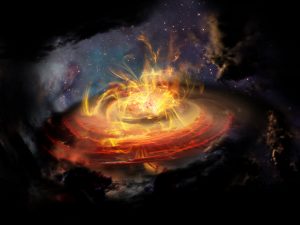Protected: Chaotically Magnetized Cloud Is No Place to Build a Star, or Is It?

Credit: NRAO/AUI/NSF; D. Berry
U.S. astronomers and astrophysicists found that stars can emerge from a wider range of conditions as previously thought. For their research, they used the ALMA telescope and the “AREPO” code from HITS astrophysicist Prof. Volker Springel.
See original press release from National Radio Astronomy Observatory (NRAO).
For decades, scientists believed that the magnetic field lines coursing around newly forming stars were both powerful and unyielding, working like jail bars to corral star-forming material. More recently, astronomers have found tantalizing evidence that large-scale turbulence far from a nascent star can drag magnetic fields around at will.
Now, a team of astronomers using the Atacama Large Millimeter/submillimeter Array (ALMA) has discovered a surprisingly weak and wildly disorganized magnetic field very near a newly emerging protostar. These observations suggest that the impact of a magnetic field on star formation is more complex than previously thought.
The researchers used ALMA to map the magnetic field surrounding the young protostar dubbed Ser-emb 8, which resides about 1,420 light-years away in the Serpens star-forming region. These new observations are the most sensitive ever made of the small-scale magnetic fields surrounding a young protostar. They also provide important insights into the formation of low-mass stars like our own sun.
Previous observations with other telescopes found that magnetic fields surrounding some young protostars form a classic “hourglass” shape – a hallmark of a strong magnetic field – that starts near the protostar and extends many light-years into the surrounding cloud of dust and gas.
“Before now, we didn’t know if all stars formed in regions that were controlled by strong magnetic fields. Using ALMA, we found our answer,” said Charles L. H. “Chat” Hull, an astronomer at the Harvard-Smithsonian Center for Astrophysics (CfA) in Cambridge, Mass., and lead author on a paper appearing in the Astrophysical Journal Letters. “We can now study magnetic fields in star-forming clouds on the broadest of scales all the way down to the forming star itself. This is exciting because it may mean stars can emerge from a wider range of conditions than we once thought.”
ALMA is able to study magnetic fields at the small scales inside star-forming clumps by mapping the polarization of light emitted by dust grains that have aligned themselves with magnetic fields.
By comparing the structure of the magnetic field in the observations with cutting-edge supercomputer simulations on multiple scales, the astronomers gained important insights into the earliest stages of magnetized star formation. The simulations – which extend from a relatively nearby 140 astronomical units from the protostar (about four times the distance from the sun to Pluto) to as far out as 15 light-years – were performed by CfA astronomers Philip Mocz and Blakesley Burkhart, who are co-authors on the paper. They used the “AREPO” code by Volker Springel, head of the Theoretical Astrophysics (TAP) group at HITS, with whom they developed a special module for the simulations that span a wide dynamic range.
In the case of Ser-emb 8, the astronomers believe they have captured the original magnetic field around the star “red handed,” before outflowing material from the star could erase the pristine signature of the magnetic field in the surrounding molecular cloud, noted Mocz.
“Our observations show that the importance of the magnetic field in star formation can vary widely from star to star,” concluded Hull. “This protostar formed in a weakly magnetized environment dominated by turbulence, while previous observations show sources that clearly formed in strongly magnetized environments. We need further research to understand how common each scenario is.”
This research was presented in a paper titled “Unveiling the Role of the Magnetic Field at the Smallest Scales of Star Formation”, by C. Hull et al., appearing in the Astrophysical Journal Letters.
NRAO Press Contact:
Charles Blue
cblue@nrao.edu
About NRAO
The National Radio Astronomy Observatory is a facility of the National Science Foundation, operated under cooperative agreement by Associated Universities, Inc.
Atacama Large Millimeter/submillimeter Array (ALMA), an international astronomy facility, is a partnership of ESO, the U.S. National Science Foundation (NSF) and the National Institutes of Natural Sciences (NINS) of Japan in cooperation with the Republic of Chile. ALMA is funded by ESO on behalf of its Member States, by NSF in cooperation with the National Research Council of Canada (NRC) and the National Science Council of Taiwan (NSC) and by NINS in cooperation with the Academia Sinica (AS) in Taiwan and the Korea Astronomy and Space Science Institute (KASI).
ALMA construction and operations are led by ESO on behalf of its Member States; by the National Radio Astronomy Observatory (NRAO), managed by Associated Universities, Inc. (AUI), on behalf of North America; and by the National Astronomical Observatory of Japan (NAOJ) on behalf of East Asia. The Joint ALMA Observatory (JAO) provides the unified leadership and management of the construction, commissioning and operation of ALMA.
About HITS
HITS, the Heidelberg Institute for Theoretical Studies, was established in 2010 by physicist and SAP co-founder Klaus Tschira (1940-2015) and the Klaus Tschira Foundation as a private, non-profit research institute. HITS conducts basic research in the natural, mathematical, and computer sciences. Major research directions include complex simulations across scales, making sense of data, and enabling science via computational research. Application areas range from molecular biology to astrophysics. An essential characteristic of the Institute is interdisciplinarity, implemented in numerous cross-group and cross-disciplinary projects. The base funding of HITS is provided by the Klaus Tschira Foundation.